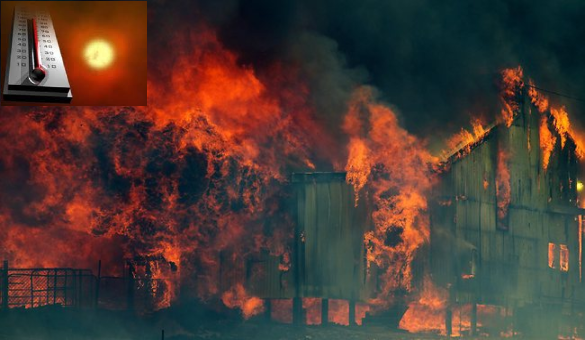Source: The Extinction Protocol - 1/05/13
A wool shed goes up in flames near the Carlton River in Tasmania, where up to 80 buildings were destroyed. Picture: Richard Jupe Source: The Australian
January 5, 2013 – AUSTRALIA - Australia’s southern island of Tasmania has experienced its hottest day since records began, with the capital Hobart sweltering at 41.8 Celsius (107.2 Fahrenheit) on Friday. The Bureau of Meteorology said the temperature in Tasmania, where records have been kept since the early 1880s, beat the previous high of 40.8 Celsius set in January 1976. “There are only three or four (days) on record over 40 degrees so it’s quite rare,” said Melbourne-based Bureau of Meteorology duty forecaster Murray Keable.
Southern Australia has been experiencing a heat-wave that has seen bushfires destroy several buildings in Tasmania, and the temperature rise to 45 Celsius in the South Australian capital of Adelaide. Further inland Wudinna, on the Eyre Peninsula, hit 48.2 Celsius and a string of other South Australian towns topped 47 Celsius. In Australia’s biggest city Sydney, thousands headed to beaches to escape the heat but the temperature was much milder, hitting a maximum of just 29 Celsius in the city centre. –Space Daily
Up in flames: In Tasmania, east of Hobart, fires destroyed as many as 65 buildings at Dunalley and 15 at Boomer Bay. There were also unconfirmed reports that one life had been lost. Fires burned out of control in Victoria and South Australia where temperatures were well above 40C and strong southwesterly winds worsened conditions. Tasmanian fire authorities were making comparisons to the conditions that led to the 2009 Black Saturday fires in Victoria that left 173 people dead, state fire chief Mike Brown declaring “we reached catastrophic fire danger ratings at times this afternoon.”
Deputy Police ommissioner Scott Tilyard said a team of experts had been sent to Forcett, near Dunalley, last night to verify a report that a person had died. “We’ve got people flying into the area at the moment to do an assessment of the Dunalley township in particular,” Mr Tilyard said. “That particular township … has been the hardest hit this afternoon by the fire that started at orcett“We have a report of about 50 people on the waterfront at Boomer Bay who are quite safe – there’s a fair bit of smoke in the area so there’s obviously concerns in relation to potential smoke inhalation, and we’ve got plans in place to, if necessary, evacuate those people by boat.” The buildings destroyed in Dunalley, by a blaze started in nearby Forcett, include a primary school, petrol station and the RSL.
Resident Peter Crocker told the ABC: “To my knowledge, I know of at least two houses between myself and Dunalley that have been lost and I know of a couple of houses at Copping that have been destroyed by fire. “We’re going to try and go back into the area and see what’s there and see if we can salvage anything out of it or put any fires out, if the house is not already gone.” Tasmanian fire authorities upgraded a warning for another fire near Bicheno on the island’s east coast where campers were being evacuated and residents encouraged to act on their bushfire plans or leave. Fires are also burning on the mid-north coast of NSW near Forster and in western parts of Queensland. Inland Australia can expect temperatures above 40C for the next week, a prolonged heat-wave that will leave southern Australia on high bushfire alert.
Meteorologists are describing the blast of hot air as unusual, given the size of the area it is affecting. Birdsville, in Queensland’s far west, had a high of 47.3C while Hobart reached a record 41.8C – one degree hotter than the record set in 1976. But it was South Australia that bore the brunt, with the wheat-town of Wudinna on the Eyre Peninsula recording a high of 48.2C and 20 people admitted to hospital with heat-related illness. Port Augusta, Whyalla, Moomba and Tarcoola all experienced temperatures above 47C. –The Australian


